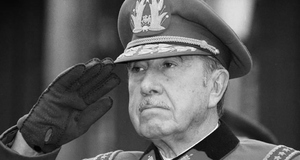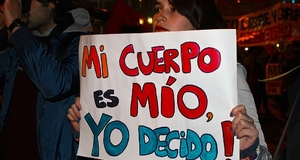"Pressing Disengagement:" Chile's Transition to Democracy After Augusto Pinochet's 1973 Military CoupThe GFDD’s demonstrations also caught the attention of the Roman Catholic Archdiocese of Santiago, which quickly became an outspoken ally. In 1976, using the financial and political resources of the archdiocese, the GFDD was subsequently re-christened the Vicariate of Solidarity of the Catholic Archdiocese of Santiago (Wyndham & Read, 33). To the Pinochet regime, the Roman Catholic faith—particularly in Latin America as a whole— was a formidable force to be reckoned with. Roman Catholicism had and still has enormous influence in Latin America, as most Latin American countries predominantly identify as Roman Catholic. Soon after it's formation, the Vicariate of Solidarity used it's expanded resources to stage demonstrations that gained a much wider audience in the international sphere. The United States kept cautiously-aware of Pinochet’s dictatorship in the wake of the assassination of Chilean diplomat Orlando Letelier in Washington D.C. On September 21, 1976, Letelier and his assistant were killed instantly when a bomb attached to their car exploded (Collins, 72). The American public, bombarded with media images of Letelier’s charred-car and the raging-outcries of the Vicarate of Solidarity’s demonstrations, openly-condemned the human-rights violations in Chile (Collins, 72). When it appeared as if the Archdiocese of Santiago had paralyzed Pinochet’s regime, he used a familiarly powerful tactic: increasing his regime’s perceived-legitimacy. In March 1978, Pinochet declared a blanket amnesty for any Chilean citizen who fought against his regime between September 11, 1973 and March 10, 1978 (Walker, 123). At first glance, this gesture appeared like a long-overdue apology to the Chilean citizenry. However, it was loaded with ulterior motives used to wholly benefit Pinochet and his regime. While thousands of Chileans were pardoned, it soon became clear that Pinochet himself was pardoned as well (Novak, 296). Many reasoned that a commitment to human rights could not be undertaken unless a leader agrees to compromises among their citizenry (Walker, 127). When human rights activists realized this alarming fine print, they condemned the amnesty as nothing more than a symbolic gesture (Walker, 123).The blanket amnesty unleashed a domino-effect of human-rights organizations taking-root under Chile. The Vicarate of Solidarity joined forces with Chile’s Truth Commission, a similar organization that shared many of the same goals. However, Chile’s Truth Commission dedicated itself wholly to investigating of human rights violations that ended either in disappearance or death (Novak, 296). To give much-needed publicity for both groups, the entirety of Chile’s Catholic leadership declared 1978 as “The Year of Human Rights in Chile” (Walker, 123). Pinochet, anxiously watching the foundation of his grip on Chile loosening, openly-condemned Jimmy Carter’s administration for involvement in Chilean affairs, a move that many of Pinochet’s comrades believed showed significant weakness on the regime (Walker, 126; Byman & Pollack, 135). Once again, Pinochet tried to increase his legitimacy, this time by completely-overhauling the Constitution in 1980. This new Constitution successfully integrated the regime’s military into the overall governmental system (Tanner, 394). As history shows, the one Achilles Heel of the document proved to be the plebiscites called every eight years to determine if the regime would remain in power (Bernath-Plastaid & Rennebohm, 2008). However, this inherent weakness in the constitution was not initially-evident because Pinochet increased his power without concern. In 1981, Pinochet expanded his power by adding 29 transitory articles to the constitution. One article in particular—article 24—bolstered his regime by allowing: “…persons to be held in their homes or places other than jails for up to twenty days; rights of assembly and free information may be restricted; political opponents of the regime may be expelled or excluded from Chile; and persons may be banished, summarily, for three months or internal exile” (Tolbert, 2001). In no uncertain terms, article 24 threatened Chileans with a return to 1973 (Ma, 60). Even if an individual or group could see through his “legitimization” façade, no one would dare question his authority because a public execution would likely be imminent. Thus, even if they were not expelled from Chile, Chileans remained silent prisoners, unseen from the confines of their own homes. The 1982-1983 Chilean economic depression was a blatant indicator of the wealth disparity between the higher and lower socio-economic classes. The economic program, designed by civilian technocrats known as the “Chicago Boys,” included free-market economics in Chile. Inflation was lowered while exports were increased through liberalization and privatization of the economy. However, any positive effects this program might have had were countered by the plummeting worldwide price of copper—a key Chilean export (Truman State University, 2012). Just after the Chilean economy tanked, civilian protests became commonplace. The accompanying negative publicity and finger-pointing at the Pinochet regime caused human rights organizations to once again condemn Chile’s government. However, Pinochet exploited the violence of two extremist demonstrations groups—the Frente Patriótico Manuel Rodríguez and the Movimiento de Izquierda Revolucionaria—as a seemingly-justified excuse to inflict the protestors with pulverizing violence. Violent clashes between Pinochet’s regime and Chilean civilians continued on through 1987, when international pressure forced Pinochet to grant political concessions to Chileans. Pope John Paul II visited Chile earlier that year and, in a private closed-door meeting with the Chilean dictator, condemned Pinochet’s government as constraining the ideals of democracy (Bernath-Plaistad and Rennebohm, 2008). Combined with the United States’ regime non-recognition stemming from unequal political advertising, Pinochet subsequently began formally-recognizing non-Marxist parties. Since both politics and media were monopolized by Pinochet’s regime, the latter had to be dismantled before the former could be attacked. In many ways, since televisions reached into most voters’ homes, the political front of Pinochet’s regime could be dissolved if voters were appealed and educated prior to voting in the plebiscite. Under the Concertaci´on movement, the “No” Party was born as an alternative to Pinochet’s “Yes” re-election campaign (Crofts-Wiley, 672). The “No” party was aided by lawyers, the Comando por el No Chief Strategic Planning Branch and the Comit´e T´ecnico technical committee to conduct research on nightly television programs among voting viewers (Collins, 675-676). The research suggested that it was possible for the campaign to appeal to the senses of each viewer. Since the “Yes” campaign used bland, repetitive propaganda messages, creatively dramatic messages within the “No” campaign would make viewers more likely to vote against Pinochet (Collins, 680). The “No” campaign decided that the best way to strike a chord within the publics’ conscience was to interview working-class Chileans on the street, as well as previously-censored groups, about their views on Pinochet’s regime. Celebrities were also enlisted to advertise for the “No’s” cause, allowing the campaign to spread their message not just across Chile, but throughout the entire world (Collins, 681). Despite how Pinochet’s coup occurred fifteen years ago up to that point, the resulting testimonies resembled 1973 because of the frighteningly-familiar anecdotes of lost or killed relatives After analyzing the testimonies, the “No” campaign concluded that people were not afraid to express their hatred of Pinochet’s regime—as long as they were assured security and confidentiality (Collins, 675-676). Thus, the Pinochet situation was more of an affective process than an ideological one (Collins, 677). Once the “No” campaign had assembled it's media campaign, it fought back-to-back on nighttime television against the “Yes” campaign on the Franja Electoral. The electoral campaigns acted as a revolving door, with each side being switched every fifteen minutes (Collins, 672). After watching each campaign, it quickly became apparent that, not only was each side advocating a different standpoint, but the techniques that they used were starkly different as well. Compared to the “Yes” campaign’s reliance on 1973-era threats, the “No” campaign painted a picture of an idealized future.Continued on Next Page » Suggested Reading from Inquiries Journal
Inquiries Journal provides undergraduate and graduate students around the world a platform for the wide dissemination of academic work over a range of core disciplines. Representing the work of students from hundreds of institutions around the globe, Inquiries Journal's large database of academic articles is completely free. Learn more | Blog | Submit Latest in Political Science |














